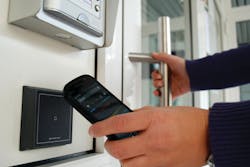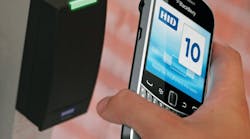The Near Field Communications (NFC) technology has already emerged as the leader in the mobile payment market, with Frost & Sullivan projecting it will reach $41.87 billion by 2015. However, rapid growth in access to NFC-enabled smartphones and other mobile devices has also begun generating interest in its use for a broad array of “Internet of Things” (IoT) applications.
Indeed, Frost & Sullivan expects NFC-enabled smartphones to reach 53 percent of the overall U.S. mobile phone market by 2015. This growth coupled with a lack barriers to adoption — users are not required to modify their devices or download apps — are driving a shift in utilization of NFC technology toward more adventurous interactive marketing and authentication services.
In particular, as NFC mobile devices become commonplace, companies are quickly discovering the unique benefits of integrating the technology into Electronic Visitor Verification (EVV) systems and Digital Out-of-Home (DOOH) media campaigns. It is a frictionless experience for users because authenticity can be verified simply by holding the device close to the tag. This makes it ideal for everything from retail loyalty cards and sweepstakes promotions to tracking home health visits and patient access to educational materials.
High Security, Unique Benefits
A driving factor behind the growing popularity of NFC-enabled EVV and DOOH services is the rapid advancements in security that have all but eliminated the potential for fraud and abuse. Previously, with traditional QR codes or static NFC tags, there was no easy way to authenticate both the identity and location of an individual or item. Tags were also vulnerable to cloning and tampering.
However, next-generation “trusted tags” include security and privacy attributes that change on every tap. This provides a secure audit trail and make taps uncloneable.
By optimizing security and convenience and eliminating the need for special readers or other equipment for authentication, trusted tags deliver two significant benefits for IoT applications: proof of presence and small data analytics.
Proof of presence is the concept of knowing that a person or device is performing a unique interaction with an object and not able to replay or replicate that interaction without the object physically present. If, for example, an NFC tag is secured to a physical location, it can prove the presence of a person at the location via the verification of a unique interaction.
Small data analytics is the ability to determine outcomes based on an individual’s actions, as opposed to big data that is used to analyze overall or population trends. Collecting more data about an individual transaction enables more powerful analytics and deeper insights into the consumers behaviors in response to campaign materials or other elements.
For example, small data analytics can provide deeper insights into the 20 movie trailer downloads generated by a single promotional poster by distinguishing between taps and shares. If one person taps the poster, then shares the URL to the movie trailer 19 times, it signals an ineffective poster but engaging trailer. The opposite – 19 taps but just one share – signals an engaging poster but dull trailer.
Both of these benefits are illustrated by the application of trusted tags in the home health and DOOH markets.
Compliance with EVV Mandates
With Medicare reimbursements for home-based care reaching $18.4 billion in 2011 and state Medicaid program reimbursements hitting $12.7 billion for beneficiaries’ personal-care services, it is no surprise that fraud rates are equally high. Billions of dollars have been siphoned from Medicare, Medicaid and private insurance companies for in-home services that were never provided.
Several embattled states are hoping to staunch the flow of fraudulent dollars by requiring home healthcare agencies to implement EVV to prove that a caregiver was physically present in the patient’s home for the required length of time. Proximity technologies like NFC or Bluetooth Smart (BLE) satisfy these requirements by enabling highly secure EVV systems that are both easy to use and impossible to defraud.
Tamper-proof tags are attached to or embedded into an object inside the patient’s home in such a way that they cannot surreptitiously be removed or altered. When the caregiver arrives, they tap the object with their BLE- or NFC-enabled device to communicate secure information to a cloud-based authentication platform. Tag data has identification attributes that change on every tap, thereby providing an indisputable and auditable EVV record for home health agencies to use for billing and reimbursement.
Top NFC tag solutions also integrate seamlessly into most agencies’ clinical and administrative management software systems. This allows data collected at the point of care to be transmitted back to the agency in real-time for improved care coordination, faster and more accurate claims processing and advanced analytics.
Building Consumer Relationships
In the DOOH market, trusted tags eliminate abuse of retail loyalty programs, gaming and sweepstakes campaigns connected to marketing displays by requiring consumers to interact with an authentic tag to generate an entry into or otherwise participate in a promotional program.
For example, one pilot program underway in a major metropolitan area embeds trusted tags in digital signage displayed in public transportation. Passengers tap the sign with their mobile device to win a free ride. In addition to creating an instant connection with each passenger, trusted tags enable advanced analytics by providing highly reliable and measurable small data that can be leveraged to refine campaigns on the fly to enhance their effectiveness.
Another illustration of the frictionless experience enabled by trusted tags is the “Film for All Friday” campaign conducted on behalf of the 2014 Tribeca Film Festival by Tamoco, a global leader in mobile marketing technology and analytics.
Tamoco embedded trusted tags into promotional posters on display at participating retail outlets. Fans who visited these locations over a four-day period received free tickets by tapping the posters with an NFC-enabled smartphone or tablet. Over the course of the promotion, posters were tapped 8,195 times.
The unique security attributes of trusted tags allowed Tamoco to verify proof of presence, and also showcased the flexibility of the firm’s NFC-enhanced marketing solutions. Trusted tags delivered an interaction that was secure yet effortless for participants, creating an unbreakable connection between the festival and film-loving consumers.
A Frictionless Experience
By enabling smartphones and other NFC-enabled devices to effortlessly double as tag readers and communicate with authentication services, trusted tags allow companies that were previously stuck on the IoT sidelines to begin leveraging a vast array of marketing and authentication opportunities. They enable secure transactions, drive advanced analytics and instill confidence that individuals scanning the tags are both who and where they claim to be.
For EVV and DOOH in particular, broad access to NFC-enabled devices and a growing acceptance of mobile interactions are coming together to drive innovation, reduce fraud and build consumer relationships in a way not previously possible.
About the Author:
Mark Robinton is the technology innovation manager for HID Global, a worldwide leader in secure identity solutions. He is responsible for incubating new technologies and solutions including the use of NFC, most recently in the company’s HID Trusted Tag Services. Mark can be reached at [email protected].



